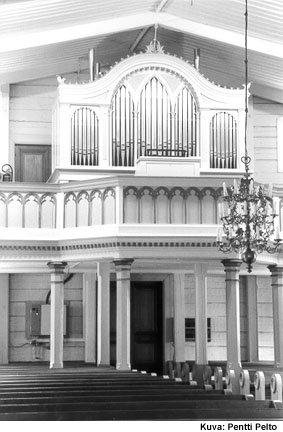
|
HISTORICAL ORGANS IN FINLAND 
Mynämäki, Karjala- Wikström, Karl Gustav 1894
- 9 stops, 2 manuals and pedal
- mechanical action and pneumatic stop action
The Neo-Gothic steepled nave church in Karjala parish in the Province of Turku was built to plans by architect G.Th. Chiewitz and completed in 1869. The church has two lower transepts.
The organ built by Karl Gustav Wikström in 1894 was originally to have had twelve stops, but only nine were completed. The valve bellows and upper boards of the remaining three stops were left unused to await a financially more secure future time. In 1966, K.J. Hirvenoja instrument repairers performed a renovation in which the disposition was altered to a substantial extent. A blower was also added. In 1984, Jouko Pirkkanen dismantled Hirvenoja’s changes to restore the organ to its original state as far as possible. For instance, he made use of pipes from the Wikström organ in Askainen, which had been dismantled some years before. The originally missing stops were not added; the organ still has only nine stops.
The Karjala organ is the only Wikström organ that has been preserved in working order. This, along with its beautiful sound, makes it a valuable instrument.
Appearance
The façade of the organ is divided into three arched flats, of which the middle and largest one is further divided into three flats topped with pointed arches. All flats are symmetrical. The façade is topped with a strongly curved frieze that knits the façade together into a single element. The decoration is Neo-Gothic.
The Manual I pipe ranks are immediately behind the façade. Behind this and an access space is the Manual II swell box, and behind that are the Pedal pipe ranks. The console is in front of the organ, and the organist sits facing the church.
Technical features
The chests are pneumatically operated stop channel chests. The fold bellows is under the manual chests. The feeder bellows is operated with a hand lever fitted to the right end wall of the organ. Building light, manually operated wind supplies was Wikström’s speciality.
The keys have celluloid and ebony coverings, and the stop knobs are in one row above Manual II. The couplings in the console have a mechanical action, except for the pneumatic octave coupling. The stop action is pneumatic, although the fixed couplings and tutti can be organized mechanically. The action is mechanical from the console onwards but is transferred to pneumatic below the façade: there are pneumatic relays at the edges of the chests.
Musical properties
The original Wikström pipes are of spotted metal, with equal proportions of tin and lead. Their outer surface has the typical mottled pattern. The lead is concentrated in the spots, while the areas between the spots have a higher tin content. The open pipes are tuned using tuning slots.
The sound of the organ is rich and refined. The pipes speak softly and have a tranquil, singing tone.
Disposition
Manual I, C-f3 | Manual II, C-f3 | Pedal C-d1 |
Borduna 16’ (c0-) | Violin Principal 8’ | Subbass 16’ |
Principal 8’ | Gedackt 8’ | |
Melodia 8’ | Dulcet 4’ | |
Oktava 4’ | | |
Trompete 8’ | | |
| | |
| | |
| | |
| | |
| | |
| | |
| | |
| | |
|
|
|
Couplings: II-I, II-I 4’, I-Ped, II-Ped. | | |
piano, forte, tutti. | | |
Shifting movement. | | |
The disposition of the organ when | | |
it was completed was the same as it is now. | | |
| | |
| | |
| | |
| | |
| | |
| | |
| | |
| | |
Further information
Erkki Valanki, Urkujenrakentaja K.G.Wikström, self-publication, Kangasala 1979.
Jouko Pirkkanen, Karjala Tl. kirkon urut, Rakentanut K.G. Wikström vuonna 1894 – Niiden vaiheista ja rakentajasta. Raportti korjaustyöstä 1984.
|